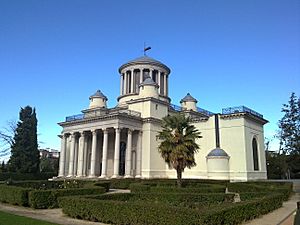Royal Observatory of Madrid facts for kids
Quick facts for kids Royal Observatory |
|
|---|---|
| Native name Spanish: Real Observatorio de Madrid |
|
 |
|
| Location | Madrid, Spain |
| Governing body | Instituto Geográfico Nacional (Spain) |
| Official name: Real Observatorio de Madrid | |
| Type | Non-movable |
| Criteria | Monument |
| Designated | 1995 |
| Reference no. | RI-51-0009078 |
| Lua error in Module:Location_map at line 420: attempt to index field 'wikibase' (a nil value). | |
The Royal Observatory of Madrid is a famous old building in Madrid, Spain. It sits on a small hill next to the beautiful Buen Retiro Park. It was built way back in 1790 and has been a place for science ever since!
Today, it's home to the Spanish National Observatory. Scientists there also study geophysics, which is about the Earth's physical processes. Both are part of Spain's National Geographic Institute. Besides being a cool building, the Observatory has many old science tools and a huge collection of books and documents. Since 2002, Rafael Bachiller has been in charge as the director. In 2021, something really special happened: the Observatory became a UNESCO World Heritage site! It's part of an area called the "Paisaje de la Luz" (Landscape of Light).
Contents
A Look Back: History of the Observatory
How the Idea Started
In the 1700s, a smart scientist named Jorge Juan had a great idea. He suggested to King Charles III that Madrid should have its own special place for studying the stars. This was part of a bigger plan for Madrid to have a "science street."
This street would include the Museo Nacional del Prado (which was first meant to be a science museum), the Royal Botanical Garden, and the Royal Astronomical Observatory. This big plan showed how important science and beautiful buildings were during the Age of Enlightenment in Spain.
War and Damage
Sadly, in 1808, a war called the Peninsular War began. Napoleon's soldiers invaded Spain and took over the Observatory. The building, which was almost finished, got badly damaged during the war. Even worse, the French soldiers destroyed a huge telescope made by William Herschel. It was one of the biggest telescopes in the world at that time!
Bringing it Back to Life
After the war, the Observatory wasn't doing so well for a while. But in the mid-1800s, under Queen Isabella II, it got a fresh start. An architect named Narciso Pascual Colomer helped fix up the main building.
During this time, a large "meridian circle" telescope was put in. This special telescope was used for over a hundred years to figure out the official time in Spain!
New Additions Over Time
Throughout the 1800s and 1900s, more buildings were added to the Observatory grounds, including a museum. In the early 1900s, they even built a full-size copy of that huge 25-foot Herschel telescope that was destroyed in the war.
Building Design: Architecture of the Observatory
The famous architect Juan de Villanueva designed the Observatory for King Charles III of Spain. It's a fantastic example of Spanish neoclassical architecture, which means it looks like old Greek and Roman buildings.
The round, domed top of the building looks like a classic ancient temple. The building is very balanced and has a tall entrance with columns. These columns have fancy tops called "capitals" in the Corinthian order style.
At the very top, four smaller domes sit around a large central dome. This main dome is surrounded by sixteen columns, but these are in the Ionic order style. In the mid-1800s, Pascual Colomer added the two small domes near the main dome. Later, in the 1970s, Antonio Fernández Alba completely restored the building. He even won an award for his work in 1980!
Amazing Tools: Observatory Equipment
Soon after it was built, the Observatory got a huge 25-foot reflecting telescope from William Herschel. This amazing tool was taken apart during the Peninsular War and only parts of it survived. But in recent years, a new version of it has been built!
The Observatory also has two original 7-foot telescopes made by William Herschel. You can also see a Foucault pendulum, which shows how the Earth rotates. There's also a 4-meter ruler that was used in the 1800s to measure distances across Spain very accurately.
What Happens There Now: Current Use
Madrid has a lot of city lights, which makes it hard to see faint objects in space with optical astronomy (using light). Other places in Spain are much better for this, especially the Canary Islands. The Canary Islands are one of the best places in the Northern Hemisphere for optical and infrared astronomy, after Hawaii.
So, the scientists working at the Observatory today don't usually look through telescopes in Madrid. Instead, they collect and study data from telescopes all over the world and even from space telescopes!
You can visit the Observatory if you arrange it beforehand. When you visit, you can see the historic scientific equipment and also the library, which is inside the beautiful Villanueva building.
See also
- Spanish National Observatory
- List of museums in Madrid
 In Spanish: Real Observatorio de Madrid para niños
In Spanish: Real Observatorio de Madrid para niños

